Ever wanted a cheerful teddy bear for a dog? The schnoodle is the perfect option.
Affectionate and charming, these dogs are the perfect family dog. They are natural entertainers, who love to be the center of attention.
A schnoodle can cost anywhere from $1500 to $4000. Generally speaking, the more expensive the pup, the better their pedigree will be.
They are great for families, couples or singles – they are commonly used as therapy dogs.
TABLE OF CONTENTS
What is a Schnoodle?
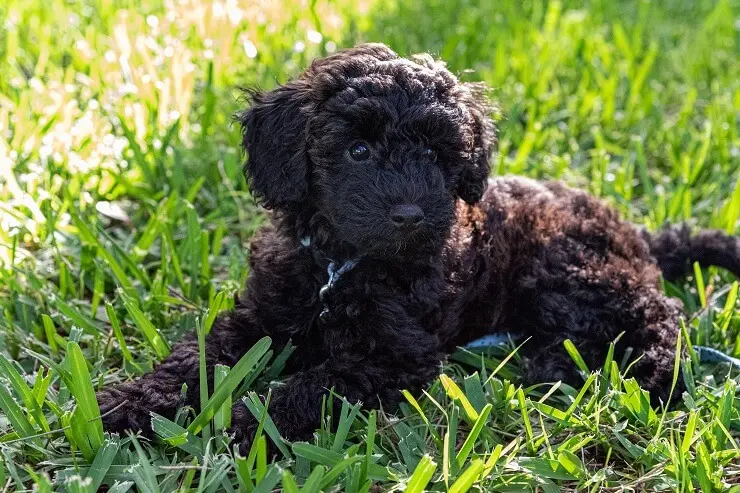
From Adobe Stock
The Schnoodle is a cross between a Schnauzer and a poodle. They can come in 2 sizes – miniature or standard. It was first bred in the 1980s when poodle hybrids started to gain popularity.
Both parent breeds have miniature and standard sizes – they also have very interesting histories.
The Standard Schnauzer first originated sometime in the middle ages on the farms of Bavaria. They were multi-taskers, who could herd livestock, guard the home and hunt. They became popular in the show scene as the ‘wire-haired pinscher’ and were finally popular in America by the 1920s. The Miniature Schnauzer was more specialized, as a barnyard ratter. The standard and miniature Schnauzer are two separate breeds with the same heritage.
The Poodle also originated from Germany, around 400 years ago. They began as a duck hunter breed, but later grew popular with the French aristocrats. They loved the Poodle’s elegant look and intelligence. They were natural entertainers and had an excellent truffle hunting nose.
The Schnoodle is not recognized by the American Kennel Club (as it is a hybrid) but both parent breeds are. The Standard Schnauzer is part of the working group, and the miniature schnauzer is part of the terrier group. The Poodle is part of the non-sporting group.
Schnoodle Appearance
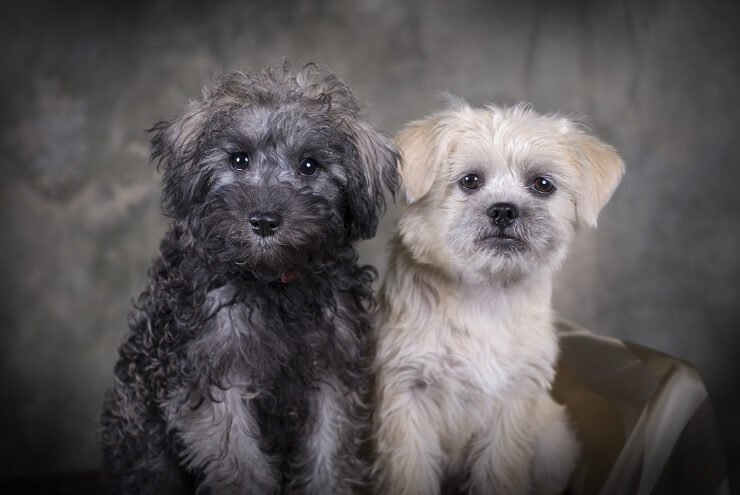
From Adobe Stock
There is a lot of uncertainty when it comes to the appearance of a cross breed like the Schnoodle. However, there is no doubt they will have a sweet and gentle look about them.
They are commonly described as teddy bears.
Schnoodles can look quite different from each other, including puppies from the same litter. They can look more like a schnauzer or could favor more of a poodle look. Or course, they could have a mix of both looks.
They will have a well-proportioned compact body and a handsome face.
Alert dark, round eyes and high set ears. Ears can be unpredictable as Poodles have floppy ears whereas Schnauzers have erect ears, the Schnoodle could have either! Their muzzles are short and slightly concave.
Height and Weight
Both Poodles and Schnauzers have two sizes, miniature and standard, so depending on the pups’ parents, there is no way of telling how big they can grow. What we can do is look at the various sizes the parents can grow to and make a rough estimate from that.
- Miniature Schnoodle: 10-20lb and 14-15 inches tall
- Standard Schnoodle: 30-60lb and 15-20 inches tall
Females generally will be smaller than males.
Colors
Schnoodles are often one solid color, they don’t tend to have any color markings, but with their unpredictable appearance, anything is possible.
Poodles have many coat color possibilities. There are 10 official poodle colors according to the Poodle breed standard, while the Schnauzer only has 3.
The most common colors seen on a Schnoodle are:
- Black
- Sable
- Grey
- Silver
- Apricot
- Brown
- Black and White
- Black and Tan
Coat
Two words that describe the Schnoodle’s coat perfectly are soft and fluffy!
They are often said to be hypoallergenic as they shed very little, however there is no guarantee that they won’t shed at all.
The Schnoodle may inherit the Schnauzer’s wiry, medium length double coat, or it could inherit the Poodles long, thick curly/wavy coat.
Unfortunately you probably won’t know their coat type until they are fully grown.
Schnoodle Personality and Temperament
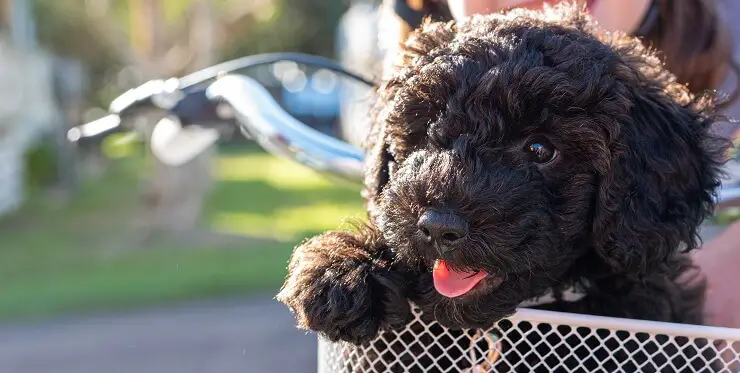
From Adobe Stock
Schnoodles are happy-go-lucky dogs, fun loving and intelligent.
They want to be the center of attention and love nothing more than being surrounded by their family.
There is never a 100% accurate prediction to how a Schnoodle will act as they could inherit quirks from either parent breed. To get a better understanding of how the Schnoodle will act, we should look at their parent breeds.
Schnauzers
Sociable, high-spirited and enthusiastic. They were bred as hard-working farm dogs for hundreds of years.
Protective of their home and loved ones, they are perfect watch dogs.
They are very loyal and are tolerant of children, and will enjoy playing with them.
This pooch is wary of strangers and acts aloof when meeting someone for the first time but are friendly once they have warmed up to them.
Poodles
Bright and intelligent, Poodles are friendly dogs. They will get along with anyone and love their family the most.
They are lively, playful and eager to have fun with their family. Poodles are proud athletes and are very energetic.
This dog is very attentive and emotionally intelligent. Often appearing telepathic, poodles can pick up on your body language. Poodles are emotionally sensitive, meaning they are more likely to develop separation anxiety if you leave them alone for too long.
So what does this all mean for your Schnoodle?
Schnoodles are guaranteed to be friendly dogs as both the Poodle and the Schnauzer have gentle dispositions.
They are great with kids and will enjoy playtime and will love the extra attention only children can give them.
Be aware of the Schnauzers prey drive, as a hunting dog they will want to chase small animals and maybe even small children. However, with the Poodle genes, this instinct may be diluted enough in which case it can be easily trained out.
How to Train a Schnoodle
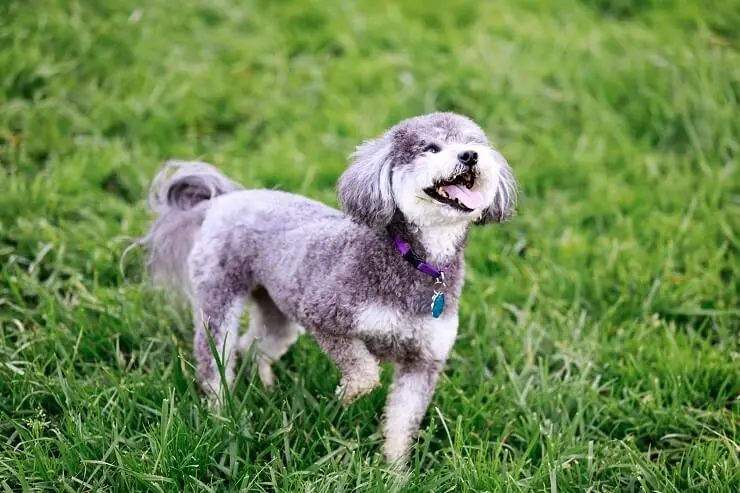
From Adobe Stock
Even though the Schnoodle is very intelligent, they can be very stubborn. The Schnauzer can be headstrong, so they need a firm hand and a confident trainer.
Schnoodles can get bored easily from the same training techniques, so make sure to mix it up often enough to keep them entertained.
Positively reinforcing dog training is the best way to teach your dog right from wrong. You should give your dog a treat or praise when they do something you want or when they stop an unwanted behavior.
Socialization is vital, without it you risk them becoming anxious around new dogs and people.
Socialize your Schnoodle with other dogs, people and children. Make introductions somewhere that is neutral or take them to a puppy class. Invite visitors round regularly, show them new experiences and let them know it’s a good experience. Praise and treats would not go amiss during this process.
They are extremely intelligent, thanks to their parent breeds. This means they need a lot of mental stimulation. Take them for a walk somewhere they have never been before, new sights and smells really enrich their day.
Play hide and seek with their treats and toys, give them a puzzle feeder or a simple game of fetch.
Caring for a Schnoodle
The Schnoodle is easy going, playful and cheerful. However, they may have moments where they will be bouncing off the walls, or when they need attention from their special person.
Schnoodles will attach themselves to one person in the family but will love everyone.
They are energetic dogs, meaning they need a lot of activity during the day. They might not shed that much, but that does not mean they don’t need grooming. Brushing and clipping is required with a thick coated dog.
Intelligent and mischievous, these dogs need a secure home to prevent any escape.
They will fit in with any household: couples, singles, empty-nest families or families with kids. As long as you have a big house with enough space for them to run around in, they will love their new home.
Exercise Requirements
As the Schnoodle has working dog parent breeds, they will have a lot of energy.
Without exercise they can become restless and frustrated. 60-90 minutes of exercise each day is required with a standard breed and 30-60 minutes for a miniature size.
Take them for a walk, hike or jog – there are so many options with an active dog like this. As long as you are enjoying yourself, they will be as well!
Schnoodles are retriever dogs at heart, so they would love a game of fetch. Take them to dog parks, a well socialized pup will love meeting new friends. Just be sure to keep them leashed as they could go running off to chase a squirrel.
Grooming and Shedding
As said before, a Schnoodle’s coat can be difficult to predict, it can be either wiry and long like the Schnauzers, or thick and curly like the Poodles.
Shedding should not be too much of a problem with this cross breed; however this does not mean they are 100% hypoallergenic. They shed low amounts, but will still need to be brushed to avoid matting, tangles and dirt. Brush them at least once a week.
Schnoodles will also need their hair trimmed, their coats can get long and nobody likes having their hair in their eyes.
As with every dog, they will need their nails trimmed to avoid overgrowth, clean ears and brushed teeth.
Feeding and Diet
How much you feed your Schnoodle is dependent on their size, bigger dogs need more energy therefore more food.
Miniatures will need around 1 cup of kibble a day and standard one will need around 2.5 cups of kibble. Their meals should be spread out equally throughout the day in equal portions, breakfast and dinner.
If you choose to feed your Schnoodle dry dog food, be sure it is high-quality kibble that’s suitable for Schnauzers and Poodles, with natural ingredients and no fillers, like corn syrup.
Dry food with filler ingredients tend to be high in carbs, which is harmful for your pooch.
What you choose to feed your dog is a personal choice, just be sure to ask your vet if you want to change your Schnoodles diet.
Known Health Problems
Crossbreeds are generally said to be healthier than pure breeds. Hybrids are less likely to develop genetic disorders, thanks to the introduction of new genes into their DNA.
Hybrids have more genetic diversity, whereas pure breeds fall victim to inbreeding to keep their unique traits and looks.
However they can still develop health issues, some of which include:
- Progressive Retinal Atrophy– The retina of the eye starts to deteriorate and can lead to limited vision or blindness.
- Patellar Luxation– This is common in Miniature Schnoodles. It is also known as the dislocation of the kneecap, causing pain and gait issues.
- Hip Dysplasia– Common in Standard Schnoodles, abnormal development of the hip socket, causing painful arthritis and lameness.
- Addison’s Disease– Is the insufficient adrenal hormones produced, causing vomiting, poor appetite and lethargy.
- Gastric Torsion– Commonly referred to as bloat, air becomes trapped in the stomach as it twists and can cause serious problems. Common in bigger and older dogs, dogs who eat too quick and exercise straight after eating.
Not all Schnoodles will get any, or all of these issues but being aware of them will help keep your pooch healthy.
How Long Does A Schnoodle Live?
A healthy Schnoodle will live for 10-15 years.
Smaller Schnoodles are more likely to live longer than their standard sized counterparts.
Quick Breed Summary Table
| Breed Characteristics | |
| Size: | Miniature (14-15 inches) Standard (15-20 inches) |
| Weight: | Miniature (10-20lb) Standard (30-60lb) |
| Lifespan: | 10-15 years |
| Coat: | Curly and thick or wiry and long |
| Color: | Black, Sable, Grey, Silver, Apricot, Brown, Black and White, Black and Tan |
| Do They Shed: | Low amounts |
| Temperament: | Cheerful, affectionate, smart and active |
| Intelligence: | Very intelligent |
| Socialization: | Good with other dogs, early socialization is needed |
| Destructive Behavior: | Prone to barking, digging and mouthing |
| People Skills: | Great with people but wary of strangers |
| Good with Children: | Great with kids, loves to play and has a gentle disposition |
| Activity Levels: | Standard sizes (60-90 minutes) Miniature sizes (30-60 minutes) |
Summary
This unique crossbreed is a cheerful companion and will quickly become one of the family.
Smaller Schnoodles are more appropriate for those who have a more laid-back lifestyle, whereas you will have to get the walking shoes out for the Standard sized one!
They won’t shed too much but will need brushing regularly to keep them neat and tidy.
Schnoodles are loveable and playful, they live to have fun and love to be the center of attention.
Things to Consider
Schnoodles are hybrid dogs that are a combination of two dog breeds, schnauzer and poodle mix. These mix breeds can be bred with standard poodles and either giant schnauzers or miniature schnauzers. Schnoodles come in all sizes and can weigh anywhere from 3.5 kg (teddy bear Schnoodle) to 8 kg. These are active dogs with bubbly personalities.
Price
Standard Schnoodle costs anywhere from $600 to $7,000, so giving yourself a budget and searching for the best dog breeder is a must. The initial purchase cost of a Schnoodle is just the start, and their monthly and yearly expenses should be taken into consideration before committing to being a Schnoodle owner. Here is a list of the additional monthly expenses you should consider before getting a dog:
- Cost of food
- Dog sitters
- Dog walkers
- Toys
- Treats
- Health insurance
- Medicine
- Vet bills
- Grooming
- Dental care
Talking about pet insurance you could get reimbursed for every vet bill from now on! Save massively on your pet’s medical costs whether it’s an illness, injury, or wellness expense that needs taking care of.
Maintenance
Schnoodles have soft and wavy coats that do not shed. Because their luscious locks grow so quickly, they need to go for regular trims.
You should take your Schnoodle to the groomers every six to eight weeks as well as brush their locks weekly to avoid tangles. While you brush your Schnoodles coat, check for sores, rashes, and fleas. Treat your dog right away if they have fleas, and take them to the vet for analysis if they have sores or rashes on their skin.
Schnoodles have sensitive ears, so you should check their ears for redness and sores on a regular basis. Do not try and remove excess ear wax or discharge without talking to your get.
Responsibilities
Schnoodles love playing with children and other large or small dogs, and they sure do make great family dogs. They have moderate energy levels, so they are easier to calm down than high energy dogs. To keep your Schnoodle happy, you must take them on daily walks.
Commitment
Adult Schnoodles and Schnoodle puppies are fun-loving, therapy dogs that are great life companions.
Allergies
Dog lovers with allergies will be pleased to hear that Schnoodles are hypoallergenic. Some Schnoodle owners have reported that their Schnoodle does cause allergies to flare up not and again, so we recommend visiting a Schnoodle breeder a few times before bringing a Schnoodle home if you have a dog allergy.
FAQ
Q: What breeds make a Schnoodle?
A: A Schnoodle is a cross between a poodle and a schnauzer.
Q: What is the life expectancy of a Schnoodle dog?
A: A Schnoodle can be expected to live anywhere between 10 and 16 years.
Q: Do Schnoodle dogs smell?
A: Schnoodles have naturally oily skin, which can cause them to smell bad. Blocked glands and bad dental hygiene can make a Schnoodle smell bad too.
Q: Are Schnoodles easy to train?
A: Yes, Schnoodles are very easy to train.
Q: Do Schnoodles like to cuddle?
A: Schnoodles are very cuddly dogs and love affection.
Q: Are Schnoodles good family pets?
A: Schnoodles are amazing family pets and get on brilliantly with other dogs and small children.
Q: How often should I bathe my Schnoodle?
A: You should bathe your Schnoodle once every month.
Q: Are Schnoodles good with cats?
A: Schnoodles are usually good with cats. Schnoodle puppies that have grown up around cats grow to be more tolerant of cats in their adult years.
More Schnauzer and Poodle Mixes
Want a Schnauzer mix or Poodle mix but aren’t keen on the Schnoodle? Check out these other hybrid dog breeds:




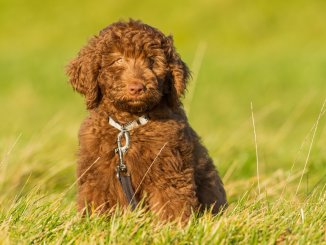

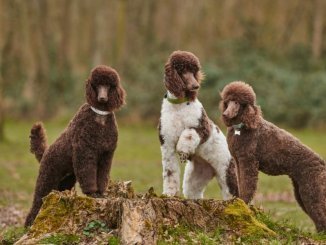
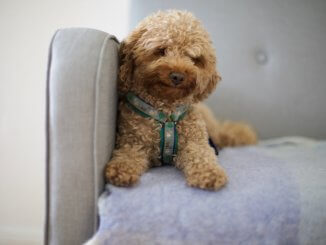
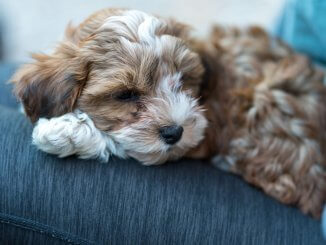
We’re looking for a puppy the miniature schnoodle may be good for us. Are there any in Detroit area?
We were always entertained by our schnoodle doing the Schnoodle 500 where he would race around the yard in large ovals. He likes to know where his pack is at all times and he positions himself strategically where he can watch everyone come and go. He also “herds” us by patrolling around us in the yard or the house. His eyesight is now failing and he identifies each of us by coming up and giving us each a sniff.